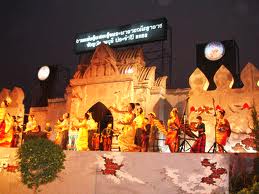Traditional merit-making ceremonies and ancient rituals to commemorate the birthday anniversary will be performed in honour of King Narai the Great as part of the opening ceremony, accompanied by cultural processions.
Offers insight into ancient Thai ways including the changing of the guards at the palace in times past and several aspects of traditional Thai life including traditional Thai homes and way of life, a traditional-style open-air market, demonstrations of folk games, Thai boxing, a song contest by village headmen (kamnan) and village elders, cultural performances by the Lop Buri Fine Arts College, a fashion show of Thai costumes and styles of dress. To complete the plot and recreate the feel of life in Lop Buri in times past, residents of Lop Buri will be dressed in traditional costumes.
The day trip and tour of Lop Buri’s historical and archaeological sites culminates in a spectacular mini-light-and-sound and multi-media presentation.
The historic city of Lop Buri enjoyed tremendous prosperity for over 3,000 years and rose to its height of civilization during the reign of King Narai the Great, one of the great kings of Ayutthaya who made Lop Buri the second capital of the Kingdom of Siam.
Noted for his sharp intellect and skills in international diplomacy, King Narai the Great was the first Siamese monarch to establish diplomatic relations with France, then under the rule of King Louis XIV. He also pursued cordial relations with other Western powers.
King Narai was fascinated by the technological and scientific developments of the West and brought western architecture, engineering, and astronomy to the Siamese kingdom. Foreign influence is clearly visible in many of the structures built during his reign as seen in the application of modern technology in the construction of an observatory and in the laying of terracotta pipes to supply water to the palace.
As King Narai spent 8 to 9 months of the year in Lop Buri, the city functionally served as a second capital city to Ayutthaya and it evolved into an important centre of administration, trade and international relations. It was also an important port of call for trade vessels heading south.
With the battle skills of King Narai’s army uncontested, Lop Buri saw the emergence of exquisite art and architecture and its cultural sophistication flourished.
In 1666 A.D., King Narai the Great commissioned the construction of the Phra Narai Ratchanivet Palace, taking twelve years to complete. A place with a rich history and fascinating past, today the whole compound is the site of the National Museum of Lop Buri which houses one of Thailand’s most interesting historical collections. With its evocative architecture and lush forecourt, Phra Narai Ratchanivet Palace provides a dramatic setting.
Date: 16-22 February 2012
Location: Lop Buri
For more information: TAT Lop Buri Office
Tel: +66 (0) 3642 2768-9




